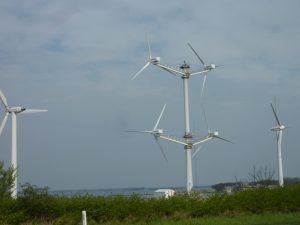Tail Wind or Head Wind
A report of the Christmas meeting of the Danish Meteorological Society (DaMS)

On the 14th of December – 10 days before Christmas – a meeting on wind energy was kindly hosted by the company Ørsted in Copenhagen. The company strategy is to be a leading player in offshore wind energy. Following a welcome by the president of DaMS, the first talk was given by Mikkel Gryning. In his presentation he dwelt on the many challenges faced when dealing with offshore wind farms. Ørsted is active in all aspects of offshore wind farm development, from concept and engineering to construction and operation. The company ambition is to have an offshore capacityof 12 GW in 2025 – corresponding to 1000 – 2000 individual modern offshore wind turbines. The technical developments of wind turbines is fast, from a hub height of about 35 m in 1991 the hub height has increased 4 to 5 times for today’s operational wind turbines and even higher wind turbines has been designed and are now being tested. The photo shows an example of an experimental design of a wind turbine that is presently being tested. Today, commercially available wind turbines have reached hub heights of around 160 m, with a rotor diameter of 164 m.
Some of the main challenges include how to cope with the wind as a stochastic resource, and the principal decision on how to operate wind farms when the electricity price is negative and traded on market terms. Post subsidy periods with no guaranteed prices and zero subsidy bids in Germany combined with increased wind energy generation, can result in a scenario where limiting renewable generation to avoid a loss in profit is the best cause of action commercially. The scenario points towards an increased interest in energy storage possibilities. Another system challenge is the variability of the system frequency, which should be kept within a very narrow band, even when large variations in the consumption of power occur. Consumers expect an energy supply security of 99.99% and wind power must help stabilize the electrical grid. A severe, but rare, challenge concerns oscillations in the internal electrical grid of the wind farm, between the wind turbine power electronic devices, which can affect the power quality and system stability of the whole wind farm. Even temperature measurements for control of the cables and to estimate available current headroom in the large (export) cables can be considered. Pricing, resource variability and system frequency challenges calls for a wind farm with an integrated storage system (and maybe even including solar panels).
All this leads to a discussion on whether the price of wind energy in the future will be wind speed dependent and on which time scale – wind energy in Denmark might be more expensive during anticyclonic conditions. This calls for better wind forecasts.
Nicolai Gayle Nygaard took over and spoke about more concrete wind and meteorological aspects of electricity generation from wind. It is impressive that the mass of the air that passes through the sweep area of a large wind turbine corresponds to the weight of 40 elephants per second for a wind speed of 10 m/s. Nicolai mostly concentrated on a project where the wakes inside an offshore wind farm in England were measured by a dual-Doppler-Radar. The wakes downwind from the individual wind turbines are clearly seen in the measurements, and the complex structure and how the wakes interact is of course important for energy production and lifetime of the individual wind turbines. Now the next step for Nicolai will be to investigate if it is possible to model the wakes in all their complexity, with a final goal to optimize the layout of wind farms. Nicolai concluded that although the wind turbines operate best in head wind, the wind industry – at least this company – has a lot a tail wind.
Traditionally the Christmas meeting in DaMS is arranged 10 days before Christmas, In Denmark one out of seven Christmas Eves are white (90% snow-cover in the country). In our country we all prefer a white Christmas and therefore the forecast for the weather on the 24th of December is a long tradition at this meeting – will it (finally) be a white Christmas this year? Two members of the society dared to provide a forecast and expressed their opinion on the weather on 24th – Axel Walløe Hansen started followed by Jesper Rasmussen – none of them foresaw a white Christmas and this unfortunately turned out to be correct. At the end Andreas Nyholm presented a Kahoot to test the knowledge of the members. One question was: How old is a photon from the Sun when it arrives at the Earth; which sparked discussion at the end of an interesting evening, but nevertheless we managed to finish the meeting according to the schedule.
Sven-Erik Gryning
DaMS President


Kommentare sind geschlossen.